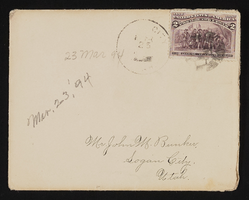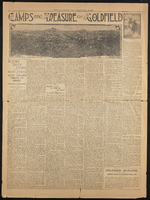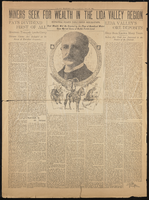Search the Special Collections and Archives Portal
Search Results

Julian Eusebio oral history interview: transcript
Date
Archival Collection
Description
Oral history interview with Julian Eusebio conducted by Cecilia Winchell, Jerwin Tiu, and Stefani Evans on June 01, 2022 for the Reflections: the Las Vegas Asian American and Pacific Islander Oral History Project. In this interview, Eusebio discusses his childhood in the Philippines countryside, helping his parents farm and harvest rice. After moving to Manila for college, Eusebio studied architecture and illustrated for comics and magazines. After moving to Los Angeles, California, Eusebio started a construction business, doing landscapes and constructing swimming pools for celebrities such as Michael Jackson. In 1992, he opened another branch in Las Vegas, Nevada. After retiring in 2010, Eusebio took up painting again and cites his favorite artists as Norman Rockwell and Rembrandt. In the remainder of the interview, he discusses his drawing process and how he started showing his artwork throughout the Las Vegas Clark County Library District.
Text

Letter and envelope from Mary Etta Syphus, Provo, Utah to John M. Bunker, Logan Utah
Date
Archival Collection
Description
From the Syphus-Bunker Papers (MS-00169). The folder contains an original handwritten letter, an envelope, a typed transcription of the same letter, and a copy of original letter attached.
Text
Joseph "Wingy" Manone Papers
Identifier
Abstract
The Joseph "Wingy" Manone Papers (1934-1996) include a partial draft of his autobiography, newspaper clippings, correspondence, magazine articles, and press releases related to his musical career. Manone also wrote music, some of which is included in the collection.
Archival Collection
Lee Plotkin Papers
Identifier
Abstract
The Lee Plotkin papers document Plotkin's political work and associations as an LGBT activist and spokesman for the Las Vegas gay community, and include correspondence, press releases, copies of his columns, institutional and legislative documents, brochures, fliers and other ephemera from 1955 to 2006.
Archival Collection
John Janney Photograph Collection on Pioche, Nevada
Identifier
Abstract
The John Janney Photograph Collection on Pioche, Nevada contains photographs of mining operations and townspeople in Pioche, Nevada from 1908 to 1934. The photographs are primarily panoramic views of the town, mines, and landscape around Pioche, where Janney was president of Pioche Mines Consolidated until his death in 1967. The photographs also depict the baseball field in Pioche, a train crossing the desert in Lincoln County, and the Lee Family.
Archival Collection
Irma McGonagill Photograph Collection
Identifier
Abstract
The Irma McGonagill Photograph Collection (1870-1925) consists of thirty black-and-white photographic prints, ten postcards, and fourteen photographic negatives showing Irma McGonagill and her family in Tonopah, Nevada during the mining boom. The images depict the town of Tonopah, mines around the Tonopah area, homes in Tonopah, and the McGonagill family.
Archival Collection
Valerie Pida Trust Records
Identifier
Abstract
The Valerie Pida Trust Records (1987-1993) are comprised of records documenting efforts by Edward "Ted" Quirk, an attorney and a board member of the University of Nevada, Las Vegas (UNLV) Foundation, to establish a trust for Valerie Pida, a UNLV student who had battled Hodgkin's lymphoma since the age of thirteen. Pida was a student at UNLV from 1985 to 1991 and was a cheerleader for the Runnin' Rebels basketball team. The records include correspondence, newspaper clippings, financial statements, and receipts that document the establishment and activities of the foundation, which operated until 1993.
Archival Collection
UNLV Libraries Collection of Lady Luck Gaming Corporation Promotional Materials and Reports
Identifier
Abstract
The UNLV Libraries Collection of Lady Luck Gaming Corporation Promotional Materials and Reports includes annual reports, financial reports, press kits, press releases, and promotional materials for the Lady Luck Gaming Corporation in Nevada, Colorado, Iowa, Mississippi, and Missouri, dating from 1993-1995.
Archival Collection


